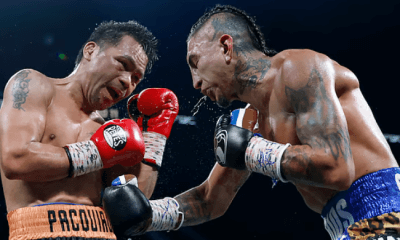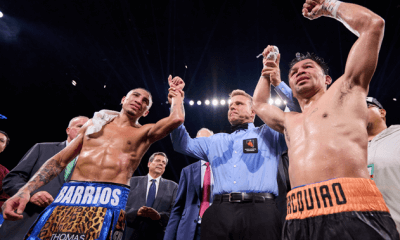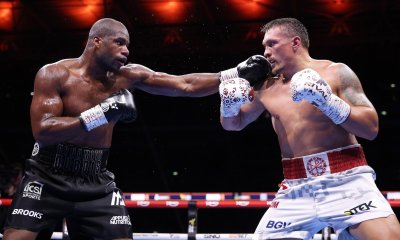Featured Articles
Is Erislandy Lara Getting the Shaft?
“Erislandy Lara, if you don’t know by now, is the best junior middleweight in the world right now,” Ronnie Shield, Lara’s trainer, told me during Christmas week. “There are a lot of good junior middleweights out there, but from a technical standpoint, no one is going to beat Lara right now.”
Despite the assertion, something many in boxing would agree with, Erislandy Lara (19-1-2, 12 KOs) seems to be getting the shaft. Coming off arguably his best year as a professional prizefighter, Lara is now left wondering why one of the fighters he knocked out last year, Alfredo Angulo, is getting the nod against superstar Canelo Alvarez for a March 2014 bout.
Lara and Angulo met last summer in Carson, California. After it appeared he may get knocked out himself, Lara stopped Angulo suddenly in Round 10 of a rugged and fan-friendly fight, landing a vicious left hand that smashed Angulo’s eye into an enormous hematoma. Lara showed everything in the fight. He easily outboxed Angulo early in the bout before having to pick himself off the floor in Rounds 4 and 9. Angulo landed devastating hooks in the fight, the kind that separate most men from their senses. But Lara took them on the chin and rose to the occasion for the win.
Then in December, Lara fought fellow southpaw slickster Austin Trout in Brooklyn, New York. The two junior middleweights were by-and-large considered to be the two most avoided boxers in the 154-pound division. While Lara’s career has been shutout thus far from big money fights against superstar competition, Trout shined in an easy win over Miguel Cotto in 2012 and came oh-so-close in a decision loss to Canelo Alvarez in 2013.
The bout with Trout was supposed to be a barnburner, but it wasn’t. Lara dominated every minute of every round in what has to be considered his most impressive performance to date. He knocked Trout down to his knees with a lead left hand in Round 11 to put a stamp on his masterpiece, a 12-round unanimous decision win over a man who dominated Cotto and went toe-to-toe with Alvarez.
But Lara, age 30, hasn’t seen much fruit from his 2013 efforts so far. Despite being the Transnational Boxing Rankings Board No. 1 contender to Floyd Mayweather’s lineal 154-pound championship, there’s been nary a mention of Lara as a possible opponent for Mayweather’s next bout. In fact, Lara seems to have boxed himself out of the Mayweather sweepstakes altogether. Does any among you foresee Mayweather moving from likely opponent (and multiple knockout loss sufferer) Amir Khan in May to someone as staunch and dangerous as Lara in September?
And Lara still can’t seem to get Alvarez in the ring. When I visited Lara’s camp back in November 2012, Luis DeCubas, Jr., Lara’s manager, told me they had been trying to get a fight with Alvarez for years. Years! He said the Alvarez camp knew how dangerous Lara was, and that he expected to have to force the issue in order to land the fight.
But the fight hasn’t happened yet, and it appears not to be on its way anytime soon. Instead, Alvarez has selected Angulo for March, likely because he considers a bout with Angulo much more winnable than one with Lara.
Lara is getting the shaft. But, maybe, it’s just his lot in life.
Lara was born in 1983 in one of the poorest areas of Guantánamo, Cuba. He never met his father. His mother, Marisol, was an alcoholic. He was raised by his grandmother, Silvia, who died when Lara was just 11 years old.
Lara used boxing to cope and began fighting in Cuba’s youth competitions. Before he knew it, he was a teenager moving up the ranks and vying for an Olympic spot on the best boxing team in the world. Lara became captain of the Cuban national team and won a world championship in 2005.
Lara attempted to defect from Cuba during the 2007 Pan American Games in Brazil. After having a few drinks with teammate Guillermo Rigondeaux, the two decided to make their move to Germany with boxing promoter Ahmet Oner, who had helped Yuriorkis Gamboa and Yan Barthelemy defect from Cuba a short time earlier. The two men were hidden away by Oner until they could be smuggled safely out of the country.
But it never happened.
The two languished for three weeks, fugitives in a strange land. Cuba worked diligently with Brazilian authorities to search for the missing boxers. Lara and Rigondeaux decided to turn themselves in. Upon their return to Cuba, the two were branded traitors and placed on indefinite suspension. The men were then confined to their homes and not allowed to fight.
“It was a pointless existence,” Lara said of the matter. His country was giving him the shaft.
Four months later, Lara again made contact with Oner. Lara set off alone with 20 strangers on a smugglers ship. The six-hour trip from Cuba to Mexico took 17 hours, and the smugglers made sure to grab 10 times more for Lara’s passage once they learned he was a championship boxer. Lara was getting the shaft again, but it was worth it.
“It was a very difficult decision to leave Cuba which is why it took me so long to leave, but I did it for the right reasons,” said Lara. “I did it to better my life and better my family’s life and that is what I’ve done. I came here to work hard and fight and obviously my ultimate goal is to move my family in Cuba over here to the United States.”
Lara has four children. Two of his children remain in Cuba with his mother, who he keeps in contact with and hopes to have come live with him in the United States. His other two children and wife are with him in Katy, Texas, a suburb of Houston, where Lara now lives and trains. Lara met his wife, Yudi, during his two-year, two-fight stint in Germany under the management of Oner. After parting ways with Oner and signing with DeCubas in 2008, Lara moved to Miami for a while, but ultimately wanted to move to Katy so he could focus on his work with Shields as well as live in a more family-friendly environment. Lara also signed with Al Haymon in 2012.
“Being on the sea, not knowing whether you are going to live or die—whether I’d make it or not,” he said. “I’m grateful to God I was able to pass that stage of my life and now that is why I work so hard in this country to make the most out of my life. I believe that God put every human being on this planet for a reason.”
Let’s hope that reason isn’t Lara getting the shaft. Despite all he’s been through to get here, despite rising through the ranks and proving himself an elite contender, Lara still doesn’t seem to be getting the fights he deserves.
Is it his style? Shields doesn’t think so.
“If you really know boxing, then you will love Erislandy Lara,” said Shields. “If you don’t know anything about boxing, then you will not love him because the kid knows how to fight. He knows what to do inside of that ring. That’s all that’s important.”
But what about television?
“The networks love it,” said Shields. “Showtime really likes him. That’s why you see him on Showtime all the time. What people need to do is really study boxing. When you study boxing, you know it’s not about two guys going in the ring and slugging it out…that’s not what boxing is about.”
Shields said the Cuban style, something much maligned by some in the boxing media today, is the epitome of the sweet science.
“The Cubans really know what the sweet science is,” said Shields. “Some people say it’s the sweet science, but they don’t fight like it’s the sweet science. Boxing is a hit-and-don’t-get-hit sport. The Cubans have perfected that. A lot of people see these guys go toe-to-toe, blood-and-guts…but those guys’ careers don’t last long. But the Cuban style, they can fight 15-20 years if they wanted to…the Cubans are boxer-punchers. They know how to hurt you. But at the same time, they’re not getting beat up. After boxing, they are able to go a live a normal life. Half the other guys out there are not able to do that.”
Despite not seeming get the fights he’s earned, Shields said he still expects big things to happen for Lara in 2014.
“I expect Lara to fight for a world title in March. Definitely, it’s going to happen in March.”
And so we wait. Will Lara continue to get the shaft? Or will 2014 be the year he finally gets the fights he deserves?
-

 Featured Articles3 weeks ago
Featured Articles3 weeks agoThe Hauser Report: Zayas-Garcia, Pacquiao, Usyk, and the NYSAC
-

 Featured Articles2 weeks ago
Featured Articles2 weeks agoOscar Duarte and Regis Prograis Prevail on an Action-Packed Fight Card in Chicago
-

 Featured Articles1 week ago
Featured Articles1 week agoThe Hauser Report: Cinematic and Literary Notes
-

 Book Review4 days ago
Book Review4 days agoMark Kriegel’s New Book About Mike Tyson is a Must-Read
-

 Featured Articles4 weeks ago
Featured Articles4 weeks agoManny Pacquiao and Mario Barrios Fight to a Draw; Fundora stops Tim Tszyu
-

 Featured Articles4 weeks ago
Featured Articles4 weeks agoArne’s Almanac: Pacquiao-Barrios Redux
-

 Featured Articles3 weeks ago
Featured Articles3 weeks agoRemembering Dwight Muhammad Qawi (1953-2025) and his Triumphant Return to Prison
-

 Featured Articles4 weeks ago
Featured Articles4 weeks agoOleksandr Usyk Continues to Amaze; KOs Daniel Dubois in 5 One-Sided Rounds













